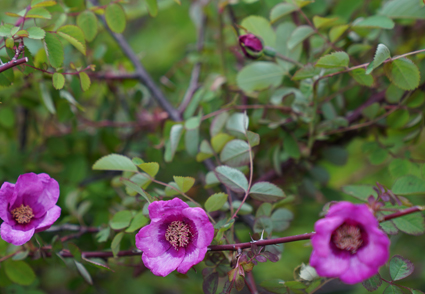Abstract
Rosa forrestiana var. maculata, a new variety of the genus Rosa from northwest Yunnan, China, is described and illustrated here. This new variety is primarily distinguished from the type variety, Rosa forrestiana var. forrestiana, by its purple spots at the petal base, a rare character in wild Rosa resources. We show the morphological features of this new variety with illustrations and photographs.
References
- Ding, B.Q. (2023) The roles of R2R3-MYBs in regulating complex pigmentation patterns in flowers. Horticultural Plant Journal 9 (6): 1067–1078. https://doi.org/10.1016/j.hpj.2023.05.014
- Glover, B.J., Walker, R.H., Moyroud, E. & Brockington, S.F. (2013) How to spot a flower. New Phytologist 197 (3): 687–689. [https://www.jstor.org/stable/newphytologist.197.3.687]
- Gottlieb, L.D. & Ford, V.S. (1988) Genetic studies of the pattern of floral pigmentation in Clarkia gracilis. Heredity 60 (2): 237–246. https://doi.org/10.1038/hdy.1988.37
- Hamilton, C.W. & Reichard, S.H. (1992) Current practice in the use of subspecies, variety, and forma in the classification of wild plants. Taxon 41: 485–498. https://doi.org/10.2307/1222819
- Harland, S.C. (1929) The genetics of cotton. Part I. The inheritance of petal spot in New World cottons. Journal of Genetics 20 (3): 365–385. https://doi.org/10.1007/BF02983155
- Hurrah, I.A., Bagri, A.S., Singh, A. & Wagh, V.V. (2022) A new variety of Geranium ocellatum (Geraniaceae) from Uttarakhand, India. Phytotaxa 530 (3): 271–279. https://doi.org/10.11646/phytotaxa.530.3.2
- IUCN Standards and Petitions Committee. (2022) Guidelines for Using the IUCN. Red List Categories and Criteria, version 15.1. pp. 79–80. Available from: https://nc.iucnredlist.org/redlist/content/attachment_files/RedListGuidelines.pdf (Accessed 7 March 2023).
- Ji, N., Wang, Q., Li, S., Wen, J., Wang, L., Ding, X., Zhao, S.-W. & Feng, H. (2023) Metabolic profile and transcriptome reveal the mystery of petal blotch formation in rose. BMC Plant Biology 23 (1): 46. https://doi.org/10.1186/s12870-023-04057-6
- Kapadia, Z.J. (1963) Varietas and subspecies, a suggestion towards greater uniformity. Taxon 12: 257–259. https://doi.org/10.2307/1217875
- Ku, T.-C. & Robertson, K.-R. (2003) Rosa (Rosaceae). In: Wu, Z.-Y. & Raven, P.H (Eds.) Flora of China, Vol. 9. Science Press, Beijing & Missouri Botanical Garden Press, St. Louis, pp. 339–381.
- Martins, T.R., Jiang, P. & Rausher, M.D.(2017) How petals change their spots: cis-regulatory re-wiring in Clarkia (Onagraceae). New Phytologist 216 (2): 510–518. https://doi.org/10.1111/nph.14163
- Rehder, A. (1940) Manual of cultivated trees and shrubs (2nd ed.). MacMillan, London, 996 pp.
- Turland, N.J., Wiersema, J.H., Barrie, F.R., Greuter, W., Hawksworth, D.L., Herendeen, P.S., Knapp, S., Kusber, W.H., Li, D.Z., Marhold, K., May, T.W., McNeill, J., Monro, A.M., Prado, J., Price, M.J. & Smith, G.F. (2018) International Code of Nomenclature for algae, fungi, and plants (Shenzhen Code) adopted by the Nineteenth International Botanical Congress Shenzhen, China, July 2017. Regnum Vegetabile 159. Koeltz Botanical Books, Glashütten.
- Turner, B.L. & Nesom, G.L. (2000) Use of variety and subspecies and new varietal combinations for Styrax platanifolius (Styracaceae). SIDA, Contributions to Botany 19 (2): 257–262. [https://www.jstor.org/stable/41968929]
- Wu, Z.-Y. (2006) Rosa (Rosaceae). In: Chen, C.-K. & Li, D.-Z. (Eds.) Flora Yunnanica (Tomus 12) Spermatophyta. Science Press, Beijing, pp. 570–600. [in Chinese]
- Yu, D.-J. (1985) Rosa (Rosaceae). In: Yu, D.-J., Lu, L.-D., Gu, C.-Z., Guan, K.-J. & Li, C.-L. (Eds.) Flora Reipublicae Popularis Sinicae, Tomus 37. Science Press, Beijing, pp. 371–453. [in Chinese]
- Yunnan Forestry and Grassland Bureau. (2022) 2022 Yunnan Statistical Yearbook. Available from: https://www.yn.gov.cn/sjfb/tjnj_2/202302/t20230215_254980.html (Accessed 3 Match 2023) [in Chinese]


